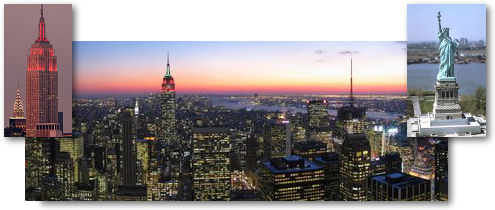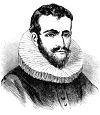
City Maps/Weather
| Fun City Facts Boeing's final assembly plant, the world's largest building, is located in Everett, Washington. The oldest carousel in the United States is located in the resort town of Watch Hill, Rhode Island. |
|
|
||||||||
New York, New York
City History |
||||||||
 New York City,is the largest city in the United States and the most densely populated city on the North American continent. The city has a population of over 8.1 million people in the city proper and over 18.7 million in the metropolitan area. New York City is a worldwide beacon for international finance, fashion, entertainment, and culture. It is also considered to be one of the world's major global cities with an extensive collection of museums, galleries, performance arts, media and financial markets. The headquarters of the United Nations also resides in New York City. |
Historic Figures
Henry Hudson| Henry Hudson |  |
| 1570-1611 Early 17th century English explorer and navigator Henry Hudson was born in England around September 12, 1570. Setting sail on the Hopewell in 1607, Hudson hoped to find the fabled northwest passage to Asia through the Arctic Ocean via the North Pole. Reaching the east shores of Greenland in June of 1607 he made his way north, mapping as he went. His expedition started out for Svalbard on June 20, 1607, reaching an island on the north end of the island group only 577 nautical miles from the north pole on July 17, 1607. He found there was not any way to go further due to the heavy ice causing him to make the decision to return to England on July 31, 1607. He made another attempt in 1608, sailing farther east along the northern coast of Norway. But once again the northern routes were blocked by ice and he was able to reach Novaya Zemlya before turning back. In 1609 another ship, the Halve Maen was commissioned for Hudson, which he took north in May of 1609. After being forced to turn back before reaching Novaya Zemlya he headed west and reached the Grand Banks, off Newfoundland, in early July of 1609. They spent the next four months exploring the east coast of North America, including Manhattan, Maine, Cape Cod and sailing a distance up the Hudson River, which still bears his name. The Dutch claimed the area and set up the New Amsterdam colony, which later became New York City. In July of 1611, Hudson's crew mutinied after surviving a harsh winter when the ship became icebound. They put Hudson, his son, and several other crew members loyal to Hudson adrift in a small boat. They were never seen from again and it is presumed that Henry Hudson died in July of 1611 somewhere in Hudson Bay, Canada. |
|
browse cities | search | get listed | spotlight | about us | contact us | policies | partners
Copyright ©2024 www.ByCityLight.com - Page Design by Erik Schubach and Tristan Chambers